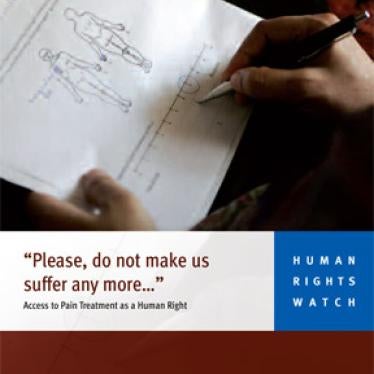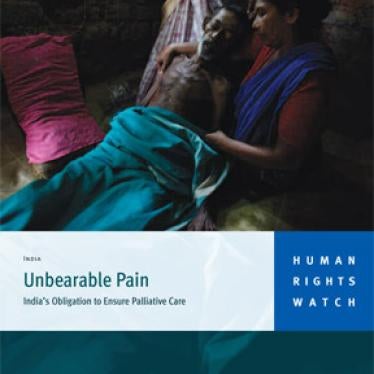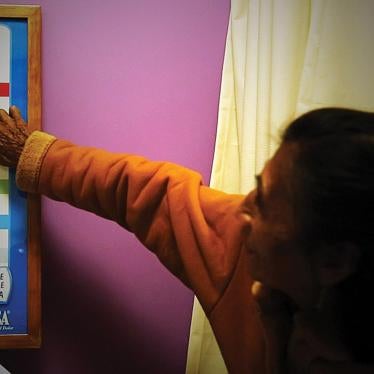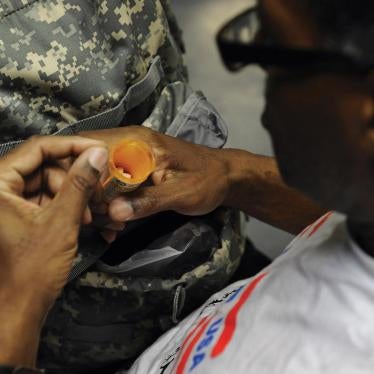|
In September 2008 a classified ad appeared in a newspaper in Colombia. It read: "Cancer is killing us. Pain is killing me because for several days I have been unable to find injectable morphine in any place. Please Mr. Secretary of Health, do not make us suffer any more..." The ad was placed on behalf of Sabina (not her real name), a 36-year-old woman with advanced uterine cancer. As is common with advanced cancer, Sabina was suffering from a lot of pain. She had a constant throbbing in her spine, extremities, head and, especially, stomach. The pain had made her completely bedridden, prevented her from ever sleeping more than twenty minutes at a time, and, maybe most significantly, made meaningful interaction impossible with her 13-year-old and soon-to-be orphaned daughter. In an interview with Human Rights Watch, Sabina's mother told us that towards the end of her life Sabina could not even touch her daughter because of the pain. Sabina's doctor had prescribed morphine, a strong analgesic that can relieve most cancer pain. But Sabina couldn't get it. Pharmacists told her mother that they had run out and said she might be able to get morphine in Bogota. But how could her mother make a 480-kilometer trip to Bogota when her dying daughter needed her at home? Driven to desperation by her daughter's suffering, Sabina's mother repeatedly wrote to the local health department asking for help and, when nothing changed, placed the newspaper ad. The newspaper ad was noticed. Officials in Bogota, Colombia's capital, promised to look into the situation and make sure Sabina got her morphine. Unfortunately, these efforts came too late. After months of suffering, it was death-not morphine-that finally relieved Sabina of her pain. Sabina's story could have happened in almost any developing country. Morphine and other strong pain medications are virtually unavailable in more than 150 countries around the world. The World Health Organization (WHO) estimates that tens of millions of people worldwide suffer from moderate to severe pain without access to treatment every year, including 5.5 million people with terminal cancer. What makes Sabina's story particularly devastating is that her suffering was entirely preventable. If she had had access to inexpensive morphine, she should not have spent her last two months wracked in agony. She would have been able to spend time with her mother and daughter instead of isolated in a world of pain and suffering.
Understanding the Palliative Care and Pain Treatment Gap Morphine is an inexpensive, safe and highly effective medication that is generally not hard to administer. According to the WHO, "most, if not all, pain due to cancer could be relieved if we implemented existing medical knowledge and treatments." Pain relief as a part of palliative care is an effective and relatively low-cost health service aimed at improving patients' quality of life. The need for palliative care and pain management in developing countries is enormous because most patients present with advanced cancer and can benefit only from such services. So how can it be that 5.5 million cancer patients, like Sabina, die in unnecessary, excruciating pain every year? Human Rights Watch research has found that one of the key reasons is the failure of many governments around the world to take even basic, low-cost steps in the three areas that WHO has said are essential to palliative care development:
Education of Healthcare Workers Surprisingly, a wealth of literature suggests that doctors-although bound by their Hippocratic Oath to relieve suffering in patients-are the biggest obstacle to improving palliative care in many countries. The problem is that most doctors never receive even basic training on the management of chronic pain. Moreover, the emphasis in pharmacology classes is that morphine can be addictive or lead to respiratory failure. Imagine how doctors would feel about chemotherapy if, as medical students, they learned that chemotherapy can cause serious damage to healthy bone marrow cells, cause vomiting, diarrhea and a whole host of other side effects but not that these side effects are acceptable since chemotherapy can also be very effective in treating cancer? The absence of pain management from medical curricula is particularly startling given that WHO introduced its Cancer Pain Relief Ladder almost 25 years ago. The ladder (see figure 1) is a simple tool that recommends the use of increasingly potent pain killers as pain becomes more severe, starting with over-the-counter non-steroid anti-inflammatory drugs like ibuprofen and ending with strong opioids like morphine. In India, Human Rights Watch interviewed many doctors who told us they had never received any training in pain management. One doctor, for example, said: "I was never taught how to treat pain. I know how to treat a fever, but not pain." Recently we came across the case of a medical doctor in India who was in severe pain, dying of cancer, but who refused to take morphine because of her fear of addiction. In fact, research shows that drug dependence is extremely rare in patients who receive opioid medications.
Drug Availability A second major problem is the poor availability of opioid medications. While the health systems generally can be weak, the lack of availability of pain medicines is often due to the fact that these medications are controlled substances and are closely regulated under international and national law. Our research identified three common types of obstacles. First, because of the need to prevent their misuse, there is no free market in controlled medications. Governments have to estimate how much of the medications they will need and supply this to the UN before any controlled medications can be brought into the country. While this does not have to be an obstacle to drug availability, many countries submit estimates that are so low that almost no patients can be treated for pain. For example, in 2008, Burkina Faso, a country in West Africa, informed the UN that it would need 153 grams of morphine in 2009, an amount that would suffice to adequately treat about eight terminal cancer patients for severe pain. Yet, an estimated 23,000 people died of cancer in the country in 2009. There are many other countries that, like Burkina Faso, request extremely low quotas of morphine and thus condemn patients to suffering. The reasons for these low estimates are probably a combination of weak health systems, a lack of official attention to the issues of pain and palliative care, and exaggerated fears of addiction or misuse. A second obstacle emerges once morphine is in the country: healthcare institutions must have a license to handle the drug. Unfortunately, many countries have adopted regulations that are so restrictive they make it hard for healthcare institutions to obtain the drug. For example, in India, healthcare institutions in many states have to obtain five different licenses from two different government agencies to purchase morphine. The licenses all have to be valid at the same time, no small task as each has its own application procedure and often a short time period before they expire. As a result, most simply do not stock morphine. In China, only larger hospitals can stock opioid medications, meaning that many people who live far from these hospitals cannot obtain them. In Sabina's case, the health department in her region had failed to ensure a supply of morphine, making it unavailable. This problem was addressed after Sabina's mother placed the newspaper ad. Finally, in sometimes overzealous efforts to prevent misuse of opioid medications, drug regulations in many countries severely restrict prescription practices. Some regulations only allow certain types of doctors, usually oncologists or anesthesiologists, to prescribe opioid medications. Other countries require prescriptions to be signed by multiple doctors or approved by the ministry of health. Yet other countries require that prescriptions are written on special prescription pads that doctors have to purchase at their own expense. Lastly, many countries strictly limit the amount of opioid medications that can be prescribed, meaning that gravely ill patients in chronic pain have to regularly visit their doctors to obtain new prescriptions.
Government Policies The third reason for the lack of availability of pain medicines is the absence of government policies to promote palliative care. The WHO recommends that countries develop national palliative care policies and integrate palliative care into national cancer and AIDS control programs. Unfortunately, national palliative care policies do not exist in most countries and often even national cancer control programs do not include a meaningful palliative care component. Given that the vast majority of cancer patients in developing countries have advanced cancer at diagnosis, this means that the cancer care system simply abandons large numbers of patients. Government leadership is particularly important because palliative care policy development requires coordinated efforts to address both drug availability and educational barriers in parallel. The experiences of countries like Uganda, Vietnam and Colombia-although there are still stories like Sabina's, the Colombian government has made important progress in improving palliative care-show that where governments develop and implement robust plans of action to address barriers, real improvements follow.
Human Rights and Pain Treatment The failure of governments to take steps to ensure access to pain medicines is a violation of their obligation to fulfill the right to health. It can also be a violation of the prohibition of torture and cruel, inhumane and degrading treatment. This is particularly true when governments know that patients are experiencing severe suffering, have the means to relieve that suffering, but willfully fail to take the necessary steps to do so. Human Rights Watch documented an example of this in India. Our research there found that more than half of the country's government-supported regional cancer centers do not offer pain management or palliative care, despite the fact that more than 70 percent of their patients have advanced cancer and need pain treatment. The government has failed to take reasonable steps to make sure that these patients get access to pain treatment. It could make the availability of palliative care a condition for receiving the designation of a regional cancer center, earmark government funding for palliative care, or initiate palliative care training for doctors at these cancer hospitals, but it has chosen not to. The result is that many thousands of patients are abandoned to excruciating pain even though the government had clear means to prevent their suffering. Human Rights Watch interviewed dozens of cancer patients who had experienced severe pain but did not have access to treatment. Many of them expressed a sentiment we usually hear from victims of torture: all they wanted was for the pain to stop. With government commitment, in many cases it can. References |
|
|
Journal Article
Pain Relief: a Human Right
Guest Message
Published in:
INCTR: Newsletter
Your tax deductible gift can help stop human rights violations and save lives around the world.
Related content
Most Viewed
-

-
September 18, 2024
Indonesia: Racism, Discrimination Against Indigenous Papuans

-
November 25, 2019
A Dirty Investment

-
January 16, 2026
Iran: Growing Evidence of Countrywide Massacres

-
January 20, 2026
DR Congo: Civilians in South Kivu City at Serious Risk







